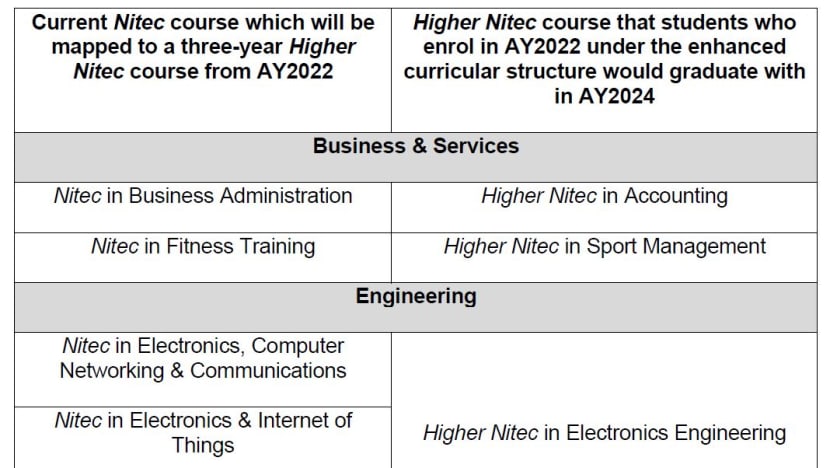New ITE curriculum from 2022 to let students get Higher Nitec in 3 years instead of 4 years
SINGAPORE: The Institute of Technical Education (ITE) will introduce a new curriculum that allows its students to achieve a Higher Nitec (Higher National ITE Certificate) in three years instead of four.
The new curricular structure will start with selected courses from Academic Year (AY) 2022, the Ministry of Education (MOE) and ITE said in a press release on Friday (Apr 30). All courses are expected to transition to the new structure by the 2026 intake.

“The enhanced curricular structure seeks to equip our ITE graduates with deeper industry-relevant skills for employment, as well as provide a stronger foundation for further education and skills upgrading over the course of their careers,” MOE and ITE said.
“This move is in line with MOE’s commitment to provide opportunities for all ITE graduates to upgrade beyond a Nitec qualification over the course of their careers by 2030.”
MOE first announced in 2019 that all Nitec graduates will have the chance to attain a higher qualification by 2030. Second Minister for Education Maliki Osman also told Parliament in March that the route to a Higher Nitec will be shortened.
Currently, ITE offers the two-year Nitec programmes and the Higher Nitec programmes, which are mostly two years, separately. As such, GCE N-Level holders who enter Nitec courses will typically achieve a Higher Nitec after four years.
It is easier for Higher Nitec holders than Nitec holders to enter polytechnic, should they wish to do so. According to the most recent Joint Polytechnic Admissions Exercise, Higher Nitec holders needed a lower grade point average to qualify for some polytechnic courses.
READ: Mental wellness curriculum launched at polytechnics and ITE colleges
Under the new structure, the Nitec and Higher Nitec curricula will be streamlined into a three-year programme by removing “overlapping competencies” between related Nitec and Higher Nitec courses, MOE and ITE said.
In Year 1, students will take broad-based foundation courses on fundamental skills needed for the relevant industry sector. In Years 2 and 3, they will take more specialised modules, leading to a Higher Nitec.
Students will also do two industry attachments in the three years – a three-month attachment in Year 2 and a six-month attachment in Year 3. The latter attachment is designed to build on the competencies of the former.
“Industry attachments will remain a key component in the enhanced curricular structure so that students continue to be equipped with industry exposure and relevant work-ready skills,” MOE and ITE said.
READ: Graduates of universities, polys and ITEs in 2021 can take free continuing education modules
As the changes comprise “a significant shift involving curriculum redesign and restructuring”, ITE will adopt a phased implementation approach.
Sixteen courses – eight Nitec and eight Higher Nitec – have been identified for the first phase of implementation from AY2022. This will involve about 2,000 students admitted into Year 1 and about 1,200 students admitted into Year 2 directly.
ITE will review the outcomes of the first phase of implementation, and make necessary adjustments including to the implementation approach and student support measures, before adding more courses under the new structure in subsequent phases after AY2024.
CURRICULUM WILL BE FLEXIBLE FOR DIFFERENT LEARNERS
The new curriculum will be flexible enough to cater to a diverse range of learners with different strengths, interests and learning needs, MOE and ITE said.
For instance, students with the abilities and aptitude can still get a Higher Nitec in a shorter duration of two years. This includes GCE O-Level holders and those who enrol into ITE via the Direct Entry Scheme to Polytechnic Programme.
Students who find it more difficult to cope will get additional learning support, MOE and ITE said.
Those who cannot complete the full three-year Higher Nitec programme can go out to work first with a Nitec qualification, comprising a transcript showing modules already taken, and complete the rest of the modules at ITE at a later stage.
Currently, more than seven in 10 Nitec graduates progress to Higher Nitec or pursue other publicly-funded upgrading pathways over the course of their careers, such as the ITE Work-Study Diploma (WSDip) Programme, MOE and ITE said.
“Students who graduate with a Higher Nitec can look forward to further upgrading opportunities – such as the expanded offerings of ITE’s WSDips,” they added.
ITE now has 30 courses under the WSDips, offering more than 600 places for students to upgrade themselves while mastering their skills in a workplace environment as employees.
READ: New programme lets ITE graduates get aircraft maintenance engineering diploma while serving NS with RSAF
The new structure was studied as part of a review into outcomes for ITE and polytechnic students, led by Dr Maliki.
Engagements with ITE’s stakeholders as part of the review showed that students aspire to pursue further education, upgrade their skills and remain nimble amid economic transformations, MOE and ITE said.
They added that ITE’s industry partners also looked forward to ITE graduates having deeper skills and an improved workplace learning experience.
ITE chief executive officer Low Khah Gek said: “The ITE curricular structure is built to be flexible and responsive to the changing and rising skills demands of industry, as well as enable ITE students to be better equipped to secure good jobs, pursue skills upgrading and build their careers.”












